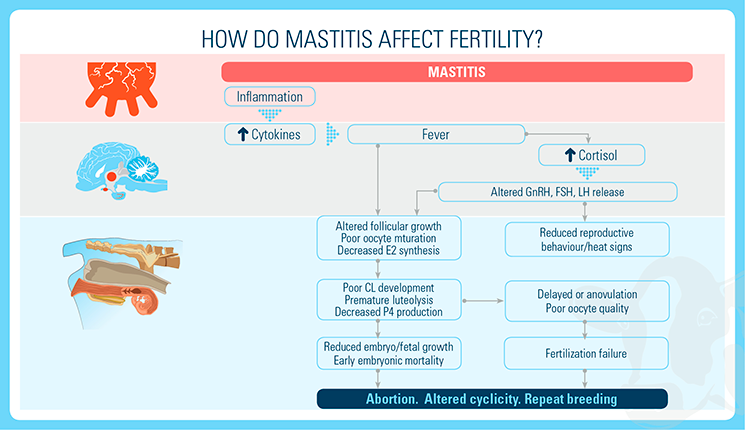

Mastitis
Mastitis is a major endemic disease in dairy cattle. Inflammation of the mammary gland and udder tissue typically occurs as an immune response to bacterial invasion through the teat canal.
Mastitis is one of the most costly diseases in dairy cattle and is also considered one of the most important diseases that affect animal welfare.
Mastitis-causing bacteria can be broadly divided into two groups based on their source.
The major contagious pathogens are:
- Streptococcus agalactiae
- Staphylococcus aureus
- Mycoplasma spp
These pathogens are well adapted to survival and growth in the mammary gland and frequently cause chronic infections. The infected gland is the main source of these organisms in a dairy herd and transmission of contagious pathogens to uninfected quarters and cows occurs mainly during milking time1.
The most common environmental pathogens are:
- E. coli
- Streptococcus spp
- Pseudomonas spp
The primary source of environmental pathogens is the surroundings in which a cow lives.
Heterogeneous Pathogens
- Coagulase-negative staphylococci (CNS). They behave as contagious or environmental pathogens.
The severity of clinical mastitis symptoms in cows depends on many factors:
- The nutritional or immune status of the cow
- The mastitis causing bacterial species and subspecies

- Change of milk aspect
- Swelling
- Redness
- Pain
- Increased body temperature
- Lack of appetite
- Sunken eyes
- Signs of diarrhea and dehydration
- Reduction in mobility, due to the pain of a swollen udder or simply due to feeling unwell
Subclinical mastitis is an inflammation of the udder without clinical symptoms and is only detectable in an increased > 200,000 cells/ml Somatic Cell Count (SCC).
Multiple studies have shown that cows with mastitis have significantly lower rates of fertility.
Clinical Mastitis:
- Increase the time calving – first insemination
- Increase the time calving – pregnancy
- Increase the number of services per pregnancy
- Increase the proportion of cows which are culled because they are not pregnant
- Increase the abortion rate in early pregnancy
Subclinical Mastitis:
- Reduce the conception rate
- Result in irregular interestrus intervals
Mastitis in cows can also affect fertility by increasing stress. The stress response inhibits the development of ovarian cyclicity, interferes with the control of ovarian function and has direct effects on follicular growth.
Inflammation is the most important reason mastitis impacts fertility2.

Clinical Mastitis
Presence of clots and flakes, abnormal texture or discoloration in pre- and post-calving secretions, colostrum or milk.
Subclinical Mastitis
- The SCC is elevated and bacteria may be present in the milk
- It is likely that an animal with a SCC of >200,000 cells per ml post-calving has mastitis
California Mastitis Test (CMT)
This is an easy-to-do, cow-side test. It is a soap-like fluid that, when added to milk, indicates the amount of DNA (=white blood cells) by changing the viscosity. It can be used during lactation to identify infected quarters.
Bacterial isolation and identification:
- Standard diagnostic procedure
- Important to obtain milk samples under strict hygienic conditions
Antibiotics
When clinical mastitis is detected, the cow is milked and treated with antibiotics: intramammary or systemic antibiotics given by the intramuscular or subcutaneous route. Intramammary antibiotics should be the first-line treatment for cows with mild, uncomplicated mastitis in a single quarter. Systemic antibiotics should be used when more than one quarter is affected, or when the mastitis symptoms are severe. Combination therapy, with both systemic and intramammary antibiotics, may increase bacteriological cure rates but should only be used based on advice from your veterinarian.
Non-Steroidal Anti-Inflammatory Drugs (NSAIDs)
NSAIDs reduce the inflammation and pain associated with mastitis. Cows treated with intramammary antibiotics and NSAIDs had lower cell counts, better cure rates and better fertility than cows treated with antibiotics alone.
Control Program
The Nacional Mastitis Council (NMC)3 has established guidelines for mastitis control: NMC´s 10 Point-Mastitis-Control Program.
Vaccination
Both commercial vaccines and herd-specific autogenous vaccines using killed whole bacterial cells are used in dairy herds. They can potentially reduce severity of symptoms and reduce new infections.
- A practical look at contagious mastitis. Canadian Bovine Mastitis and Milk Quality Research Newtwork. https://www.medvet.umontreal.ca/reseau_mammite/en/page.php?p=10&tm=i
- Kumar N, Manimaran A, Kumaresan A, Jeyakumar S. Mastitis effects on reproductive performance in dairy cattle: a review. 2017. Tropical Animal Health and Production 49 (4):663-673.
- National Mastitis Council (NMC). http://www.nmconline.org/

